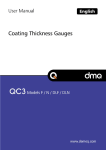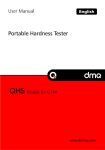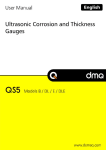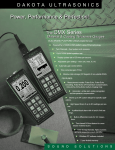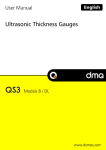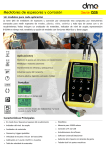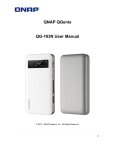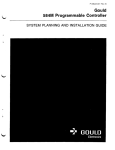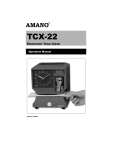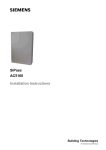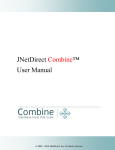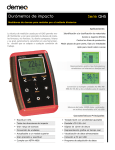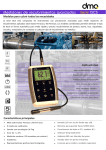Download QC5 - demeq.com
Transcript
P/N: QC5 501 – ENG – Rev. 01 – February 2014 Chapter 1 1.1 1.2 1.3 1.4 1.5 1.6 Chapter 2 2.1 2.2 2.3 2.4 2.5 2.6 Chapter 3 3.1 3.2 First steps Know the QC5 1.1.1 Front panel 1.1.2 Connectors Install and replace batteries Connecting the probe The “Q” key Display illumination and contrast 1.5.1 Display backlight illumination 1.5.2 Display contrast Locking and unlocking the keypad 1 1 2 3 5 6 6 6 7 7 Measuring with the QC5 Numerical measuring screen Graphical measuring screen (Histogram) Numerical measuring screen (Large Numbers) Keypad functions in all measuring screens Selecting the type of base Calibration 2.6.1 Getting started with calibration 2.6.2 Base calibration 2.6.3 Shim 1 calibration 2.6.4 Shim 2 calibration 2.6.5 Calibration memories 2.6.6 Using offset correction 9 10 11 12 14 15 15 16 18 19 20 22 Menu system and editing Instructions on using the menu system 3.1.1 Text editor Main menu 3.2.1 Change unit 23 24 26 26 I 3.3 3.4 Chapter 4 4.1 4.2 4.3 II 3.2.2 Alarm settings 3.2.3 Select language 3.2.4 Unit information General configuration options 3.3.1 Set time and date 3.3.2 Set time and date format 3.3.3 Set keypad sensitivity 3.3.4 Set auto-off time 3.3.5 Adjust display contrast 3.3.6 Beep activation 3.3.7 Introduction screen 3.3.8 Owner information 3.3.9 Lock configuration 3.3.10 Model upgrade licenses 3.3.11 Return to factory default settings Measuring configuration options 3.4.1 Select type of base 3.4.2 Calibration modes 3.4.3 Offset correction 3.4.4 Set number of samples 3.4.5 Set shim values for quick calibration 3.4.6 Select measuring mode 3.4.7 Set histogram range 3.4.8 Layer counter configuration 3.4.9 Select measure mode (Abs / Diff) 26 27 28 29 29 30 30 31 32 32 32 33 34 35 36 37 37 38 38 39 39 40 41 41 43 Using the Datalogger Understanding how data is organized Memory menu Creating a file 44 45 45 4.4 4.5 4.6 4.7 4.8 4.9 Actions over single files 4.4.1 View data in a single file 4.4.2 The “Q” key in a grid 4.4.3 The “Q” key in a histogram 4.4.4 Send data from a single file 4.4.5 Rename a file 4.4.6 View file size Actions over all files 4.5.1 Send all files 4.5.2 Erase all files Quick memory menu (Mem key) Connect to PC with DataCenter Datalogger configuration 4.8.1 Configure communication 4.8.2 Capture modes 4.8.3 Set number of samples 4.8.4 Select fixed batch Advanced configuration 4.9.1 Store every (N) number of samples 4.9.2 Record unit settings 4.9.3 Record date and time Tips on how to measure correctly Technical specifications Additional information Unit maintenance QC5 accessories Error messages Our website: www.demeq.com Technical support 46 47 48 49 49 50 50 50 50 50 51 52 53 54 55 56 56 56 56 56 57 58 59 61 61 62 63 64 64 III And thank you for purchasing a QC5 coating thickness gauge. At dmq we develop, manufacture and distribute software and quality control instruments offering innovation and solutions that come as a direct result of listening to your needs as a user. We apply some of the latest technology available in the industry to build instruments that are robust, precise, and easy to operate. We are convinced that our products would not be complete without permanent technical and after sales support. So in addition to a great product we offer: Quick answers to your inquiries. Unlimited access to technical information as well as application notes. Special offers for registered customers. Firmware and software upgrades at no charge. Attention to your inquiries and suggestions. We hope that the QC5 will meet and exceed your application needs. IV The information included in this manual applies to all QC5 series coating thickness gauges including models F, DLF, N, DLN, C and DLC. dmq is a registered trademark of Demeq S.R.L and its affiliate companies. The information contained in this manual is intended to educate users on the operation of the QC5 coating thickness gauges. Failure to read and understand this manual can lead to measurement errors. Decisions based on measurements and or results that are erroneous can lead to property damage, personal injury or even death. Demeq S.R.L assumes no responsibility as a result of the improper use of our instruments. Correct use of a coating thickness gauge requires: Knowing your test requirements. Having a trained operator. This manual provides all of the information needed to configure and operate QC5 coating thickness gauges. However there are additional factors that can affect tests done with this instrument. Specific information on those factors is outside the scope of this manual. When in doubt you should always seek expert advice or refer to specific textbooks on coating thickness testing. Additional information can also be found on the internet and through local government agencies as well as in technical institutes. V When a low frequency magnetic field is applied on a ferrous substrate, the signal induced by the coil inside the probe is proportional to the distance between the probe and the base. Figure 1: Ferrous base measuring principle Induced currents are produced on the metal surface when a high frequency field is applied. Induced currents and the signal obtained from the coil are proportional to the distance with the base. Figure 2: Non-Ferrous base measuring principle Using the physical principles described above, the QC5 converts small signal variations produced by the probe into precise and repetitive measurements. VI ISO 2178, ASTM D1186 for models QC5 F & QC5 C; ISO 2360, ASTM D1400, ASTM B244 for models QC5 N & QC5 C; and ASTM D7091, ASTM E376 for all QC5 models. All QC5 series coating thickness gauges are for industrial use only. The QC5 operates on two AA size batteries. We strongly recommend that you use only top brand name alkaline batteries. Disposal of your QC5 and its components must be done in compliance with all applicable regulations. Because of its complexity level, software is never really completely error free. For this reason in software controlled instruments always make sure that the operations required for your application are in correct working order. Demeq S.R.L provides a limited warranty for a period of 5 (five) years on electronic units and for 6 (six) months on probes from the date of purchase. Every instrument undergoes thorough testing during manufacturing as well as before shipping. In the event warranty service where to become necessary, Demeq S.R.L and or your local distributor or representative will make a reasonable effort to replace your defective unit with another new or used unit, while your instrument undergoes warranty repair. VII Figure 1.1: Front of the unit 1 1. Graphic LCD display with LED backlight illumination 2. Move Left key / View partial statistics (Stat) 3. Move Up key / Manually store a value (Store) 4. Move Right key / Switch to graphical measure mode screen (Graph) 5. Menu key / Enter and exit measure screen / Exit and return to menus (Home) Chapter 1 6. Move Down key / Quick access to memory menu screen options (Mem) 7. Change backlight illumination key (On, Off, Auto) 8. Enter key / Edit values on the measure screen (Edit) 9. The key: Power On and Shutdown (touch and hold for 2 seconds) / Make quick and short touches to activate special features 10. Calibration key 11. Horizontal scrolling center point (lock and unlock keypad on measure screen) 12. Vertical scrolling center point (adjust LCD contrast) Figure 1.2: Unit connectors 1. Probe connector type Lemo 0B 2. USB mini connector to connect to PC using a USB cable Chapter 1 2 The QC5 is powered by 2 (two) AA batteries that are placed in the battery compartment located in the back of the unit. To gain access to the battery compartment slide the cover as shown in figure 1.3-1 and gently push the extraction ribbon upward and slightly towards the right to release the batteries (figure 1.3-2). When you install new batteries, first insert the positive end of each battery so that it coincides with the positive pole inside the battery compartment as you see in figure 1.4-1. Always leave the extraction ribbon underneath the batteries. Figure 1.3: Removing batteries 3 Chapter 1 Figure 1.4: Replace / Insert batteries Notes Always use new alkaline top brand batteries for extended battery life. Do not mix new and old batteries. Always replace both batteries. Rechargeable batteries type NiMH can be used but will result in less time of continuous operation. Chapter 1 4 Important Do not remove batteries while the unit is powered as this may affect the Datalogger (See Appendix: “Additional information, Error Messages”) The QC5 uses a type Lemo 0B 4-pin connector located on top of the unit. All dmq probes are provided with Cal-Tag technology allowing you to easily switch or replace probes. To connect the probe simply align the red dot on the male connector with the red dot on the female connector located on the unit and press gently until connected (see figure 1.5) To release the probe hold the knurled section on the male connector and gently pull out. Never remove the connector pushing the cable. Figure 1.5: Connecting the probe 5 Chapter 1 The has three functions: 1. When the unit is off, touch the unit. for 2 seconds to power on 2. When the unit is on, touch the unit. for 2 seconds to shutdown 3. With the unit on, making short touches to the will activate special functions described in each chapter of this manual. Backlight illumination and contrast options can be changed from any screen in the unit. Touch to change the backlight illumination. Figure 1.6: Backlight illumination options Chapter 1 6 The display contrast on all dmq units is digital. Touch the white dot located in the center of the vertical scrolling bar between the keys and a contrast window will open. Move your finger towards the top and or bottom of the dotted line to adjust the contrast on your display. Figure 1.7: Display contrast adjustment To lock the keypad place your finger on the white dot located in the center of the horizontal scrolling bar between the keys. Move your finger to the right following the dotted line and a window on the unit display will open with the message Lock (see figure 1.8). Continue moving your finger in the same direction until you enter blocked mode. The window on the display will close and the blocked keypad indicator will show on the top right of the unit screen. Figure 1.8: Locking the keypad 7 Chapter 1 Sliding the finger to the left will unlock the keypad. Figure 1.9: Unlocking the keypad Important The keypad can only be locked and unlocked in the measuring screens. Chapter 1 8 The QC5 can display measurements in 3 distinct modes where each mode shows specific information. To switch modes touch the key. Touch the key to change the complimentary information displayed on the screen (mode-1 and mode-2). Figure 2.1: Numerical measuring screens 9 1. Name of the open folder where data is being stored (Page 45) 2. Average of the measurements within the group (N values) 3. Datalogger mode indicator: X: Off - M: Manual – U: Single – C: Continuous) 4. Symbol of the measured value as it relates to the nominal value in differential mode (Page 44) 5. Battery level indicator 6. Coating thickness value in the selected unit 7. Icon indicating that a value has been stored Chapter 2 8. Blocked keypad icon indicator (Page 7) 9. Probe measuring icon (probe on sample) 10. Type of base icon: FE, NF, A (Page 14) 11. User selected unit 12. Number of (N) values counter / indicator for real time group statistics 13. Position of the last stored value (Column, Row) 14. Range within the group (Max., Min.) 15. Minimum thickness value within the group 16. Average deviation within the group 17. Maximum thickness value within the group 18. Percentage value as compared to the nominal value The QC5 allows you to view graphic representations (histograms) of measured values in real time. And when you touch the key, the graphic screen will change between mode-1 and mode-2 so that you can view different complimentary information. Figure 2.2: Graphical measure screens (mode-1 and mode-2) Chapter 2 10 1. Maximum thickness value within the group 2. Minimum thickness value within the group 3. Average within the group 4. Active calibration mode (Page 15) 5. Actual coating thickness measurement 6. Battery level indicator 7. Type of base icon: FE, NF, A (Page 14) 8. Probe measuring icon (probe on sample) 9. High alarm indicator (Page 26) 10. Average within group represented graphically 11. Low alarm indicator (Page 26) 12. Reference value Y-axis 13. Histogram bars representing individual values 14. Average deviation within the group 15. Range within the group (Max., Min.) Measurements are displayed in large numbers with less complimentary information. This mode is used for quick and easy readings. Figure 2.3: Numerical measuring screen (large numbers) 11 Chapter 2 1. Number of (N) values counter / indicator for real time group statistics 2. Average within the group 3. Actual coating thickness measurement 4. Probe measuring icon (probe on sample) 5. Type of base icon: FE, NF, A 6. User selected unit 7. Active calibration mode 8. Battery level indicator Keys in all measuring screens have the following functions: : Touch to generate real time statistics based on the number of (N) stored values at the time this function is activated. : Touch to manually store the current measurement in the memory. : Touch to switch to measuring screens as follows: Figure 2.4: Measuring screens Chapter 2 12 : Touch to exit the measure screen and enter the main menu. : Touch to view quick memory access options. : Enter calibration mode (page 15). : Touch to access the select / edit mode. 2 flashing arrows will appear over editable fields: base and unit. Figure 2.5: Select / edit mode To select type of base touch To select unit touch In both cases use the save changes. - keys to edit and touch to : Short touches allow you to switch screen modes to view different complimentary information. Touch for 2 or more seconds to shutdown the unit. 13 Chapter 2 : Changes the backlight illumination. : Set display contrast. : Lock and unlock keypad. The QC5 model that you have determines what type of base you can measure: ferrous, non-ferrous, or both. On combined models where you can measure both types of bases, the base selection can be done manually, or automatically where the unit determines the type of base. Icon Chapter 2 Type of Base Mode QC5 model Ferrous Manual F / C / DLF / DLC No-Ferrous Manual N / C / DLN / DLC Auto Auto C / DLC Ferrous Auto C / DLC Non-Ferrous Auto C / DLC 14 The QC5 offers 9 modes of calibration that are explained in detail in this section of the user manual. The following table summarizes all 7 calibration modes: Abbreviation Name Base PT1 PT2 Samples Offset Base & 1-Pt 1a9 No 1a9 No 1a9 No 1a9 No 2-Points Multipoint 1-Point Base only ISO 19840 SSPC-PA2 Swedish SS 184160 Australian AS 3894.3 1a9 No 5 Yes 3 Yes 5 No 5 No To begin the calibration process make sure you are in the measuring screen and then touch the key. If the unit is set to automatic base (C and DLC combined models only) the following screen will appear: To calibrate over a ferrous base touch and for non-ferrous touch . If you want the unit to determine the type of base automatically simply go ahead and measure. Figure 2.6: Base type selection for calibration in combined models 15 Chapter 2 If the calibration mode you selected requires base calibration (measuring an uncoated base), this is the first screen that will appear on the unit: Figure 2.7: Base calibration screen 1. Indicates the type of base as well as its uniformity (page 17) 2. “Probe action” requested (lower, raise, or wait) 3. Probe status 4. Type of “sample request” (Base, Shim-1 or Shim-2) 5. Text indicating required action 6. Calibration mode (page 15) When base measurements are taken, the screen will show the number of measurements and the average value for those measurements. The first line shows the number of measurements followed by the value of the last measurement. The second line shows the average for the number of measurements that you already took. Figure 2.8: Number of samples in base calibration screen Chapter 2 16 The graphic representation of the type of base, is also indicative of the base condition. When dirt, corrosion and or other surface irregularities are present on the base material, the graphic will turn less uniform. Sharper “teeth” mean less uniformity of the base material. Figure 2.9: Base material condition indicator On figure 2.8, “ “ appears on the unit screen. Touch to end the base calibration and continue the calibration procedure using one or more shims of a known thickness values. The shim option will not appear if the calibration mode is set to “Base Only”. Important When the probe is placed on the test piece simple, the probe action indicator (represented by an arrow), gets converted to a sand watch. Here you need to maintain the probe on the test piece until the arrow asking you to raise the probe appears on the unit display. Lower Probe 17 Wait Raise Probe Chapter 2 After the base calibration procedure is concluded, the unit will ask you to measure using a shim of a known thickness. For the calibration modes that do not require base calibration (1 point, 2 point and Swedish), the calibration process begins here. Follow the on-screen instructions and measure the shim of a known thickness value over the base. Figure 2.10: Shim 1 calibration screen When shim measurements are taken, the unit will display the number of measurements. The first line shows the number of measurements followed by the value of the last measurement. The second line shows the average for the number of measurements that you already took. Figure 2.11: Number of samples in shim 1 calibration screen Select “ “ touching the key to adjust the average value to the nominal value of the shim. This option will not appear on the following calibration modes: ISO SSPC-PA2 Swedish Australian Chapter 2 18 For the methods above, the unit will activate the thickness measurement editor only when the required number of samples have been taken. Use the arrow keys to adjust the thickness to the nominal shim value and touch save. to Figure 2.12: Shim calibration thickness adjustment screen With short touches on the key, preset calibration shim values can be loaded. See on page 40. These preset values correspond to the shims that you use most frequently so that thickness values don’t have to be edited each time the unit calibrated. The calibration modes below require you to measure and adjust results on a second shim of a known thickness value: 2-Point Multipoint ISO SSPC-PA2 Swedish To calibrate using a second shim, repeat the procedure described under for “Shim 1 calibration” (page 18). 19 Chapter 2 Note The order in which you use the shims (Shim 1 and Shim 2) based on their thickness is irrelevant. Tips Better results with these calibration methods are obtained using shims with lower and higher thickness values than the actual lowest and highest measurements that you will be taking. The use of shims with thickness values that are not too close to one another is recommended. Ideally the shims should be at least 100µm apart from each other. The QC5 can hold 3 calibration memories. To access calibration memories touch the see on the unit. key on the first calibration screen that you Figure 2.4: Calibration memory menu Use the touch the calibration. Chapter 2 - to select one of the three calibration memories and to and load, or touch to the current 20 To exit the calibration memory menu touch . Important In order to obtain better results with your QC5, calibrate using a the test piece that you are actually going to measure or use a test piece sample that is in the same condition. Wrong use of calibration memories can lead to measurements with greater errors if calibration was done using samples that are not comparable to the actual test piece that you want to measure. Notes Calibration memories are stored in either a Ferrous or Non-Ferrous base with the corresponding abbreviation (FE or NF) shown next to the actual value. When using a stored calibration, the unit should be set to the same type of base as the selected calibration memory. If the unit is set to automatic base detection, the calibration memory will use the type of base selected at the beginning of the procedure. 21 Chapter 2 The QC5 allows you to increase or decrease a value (offset) to adjust for errors produced by surface irregularities. Correction values depend on the surface profile as described in the ISO 19840 standard and in the following table: Surface profile according to ISO 8503-1 Fine Medium Coarse Correction in µm 10 µm 25 µm 40 µm The calibration modes where offset correction is accepted are the ISO and Australian modes. For additional information on offset correction refer to page 39. Chapter 2 22 The instructions explained in this chapter apply to all of the menus in the unit. To scroll QC5 menu options use the cursor keys. When you reach the end of the menu and move to the next menu option it becomes circular as shown herein. Figure 3.1: Example of how a circular menu works To select a menu option touch previous menu touch and to exit and return to the . To go to the measuring screen touch touch from the main menu, or from any other menu in the unit. Figure 3.2: Going to the measure screen 23 Chapter 3 The text editor is used to input, modify and delete; letters, numbers and symbols. Figure 3.3: Alphanumeric editor screens 1. Selected key 2. Cursor 3. Text to be edited 4. Virtual keyboard Use the cursor keys on the unit to scroll the virtual keyboard until you find the character that you want to use and touch to select. Touch the key to move to the upper case virtual keyboard and to the numbers and symbols keyboard as seen on figure 3.3. There are 4 keys that are common to all virtual keyboard screens: Figure 3.4: Common virtual keyboard keys Chapter 3 24 1. Move cursor to the left 2. Move cursor to the right 3. Delete character on which cursor is on 4. Enter and exit Figure 3.5: Quick access keys for the virtual keyboard editor Touch the key to open the direct access keyboard to the most commonly used virtual keyboard keys. Each virtual key corresponds to a key on the front panel of the unit as follows: : Move the cursor to the left : Erase the character on which the cursor sits : Move the cursor to the right : Undo : Erase the character to the left of the cursor : Enter and exit 25 Chapter 3 To close the virtual keyboard touch Chapter 3 . 26 The main menu is the first list of options you will see when you exit the measuring screen and it includes the most important unit settings. Touch from the measuring screen to access this menu. Figure 3.6: Main menu Note: Memory, Cfg. General, and Cfg. Measure options are explained later on in this manual in chapter 4, and in sections 3.3 and 3.4 of this same chapter. Touch units. on Unit in the main menu to open the list of available Use the - keys to scroll the menu. Touch to select the unit. Touch to save and exit this menu. Figure 3.7: Unit options menu The QC5 has high and low alarm conditions that alert the operator when the measurement is greater than the value set for the high alarm and or when the measurement falls below the value set for the low alarm. 27 Chapter 3 Touch on Alarms to open the alarm menu options. Touch on High or Low to open the numbers editor where you can set alarm values using the cursor keys. Touch to save the alarm value that you entered and to return to the previous menu. Figure 3.8: Alarm menu options Alarm types that you can choose include: Beep: Audible intermittent alarm type. Screen: Visible alarm that causes measurements to be displayed in dotted instead of regular numbers. Light: Visible alarm that activates the display backlight illumination causing it to flash. Touch on language (which is also identified with a flag) to view available language options. Use the cursor keys to navigate available language options and touch Touch to select. to save and exit this menu. Figure 3.9: Language menu options Chapter 3 28 Select Unit Info to view information including owner data as well as the software version that your unit is running. Figure 3.10: Unit information screens To switch between unit information screens touch the To return to the main menu touch - keys. . Note The information required to obtain model upgrade licenses is included in this option. 29 Chapter 3 Touch on the Cfg. Configure option to open the general configuration options menu. Use the Touch - keys to scroll the menu. to select any of the menu options. Touch to exit and to return to the previous menu. Figure 3.10: General configuration options menu Choose Set Clock to open the time editor and use the cursor keys to set the time. Touch to save and to enter the date editor screen. After you change the date touch to save and exit. Figure 3.11: Time and date edit screens Chapter 3 30 Choose Clock Format to open the menu that allows you to set the time format (12Hs or 24Hs) and the date format (D/M/Y – M/D/Y). Touch on the option you wish to select and touch to save and exit. Figure 3.12: Date and time format menu options This option allows you to set the keypad sensitivity. The number that you set here has a direct relationship to the sensitivity of your keypad meaning that the higher the number, the more sensitive the keypad becomes. Touch on Key Sens. and use the - keys to change the keypad sensitivity. Touch to save and the keypad will already be working with the new sensitivity level. Figure 3.13: Key sensitivity setting and confirmation screens To confirm the change in sensitivity touch . If you touch any other key or the on-screen counter reaches 0.0, the sensitivity will return to 31 Chapter 3 its previous setting. Chapter 3 32 The factory default setting is 50. Under special conditions we suggest that the sensitivity level be changed. Tips If the unit will operated using security gloves we recommend that the sensitivity level be raised. To make the keypad “harder” simply lower the sensitivity level. In applications where the front of the unit may be exposed to water and or vapors the sensitivity should be lowered. The unit will shutdown automatically if no key is touched or no measurement is made after a time set by you. Touch on AutoOff to set the time before the unit automatically shuts down. Touch the - keys to set the time and touch to save and exit. Touch to exit without making changes. Figure 3.14: AutoOff time setting screen 33 Chapter 3 Contrast settings allow you to turn your screen lighter or darker where 1 is the lightest and 32 is the darkest. Touch the - on Contrast and use keys to change the contrast on your screen. Touch to save or touch to exit without making changes. Figure 3.15: Screen contrast settings Tips Contrast on LCD screens can change with temperature. Use the contrast option to compensate for changes caused by temperature to maintain optimal viewing conditions. Beep refers to the sounds that the unit makes when keys are touched and when the audible alarm is active. Touch to enable or disable the beep option. The introduction screen is the first screen that you see after the unit is turned on and includes owner information such as name, telephone number and e-mail. Touch Chapter 3 to enable or disable this option. 34 This option allows you to enter owner information (the info that would appear on the introduction screen). Touch on Set ID, enter the password (the factory default password is 12345) and touch to access user info menu options. Figure 3.16: Enter password to access the user info menu The user information that can be changed includes the following: Name: Set or change the owner name. Phone: Set or change the telephone number. Name@: Set or change the e-mail (before the @). @Domain: Set or change the domain for the e-mail (after the @). Edit Pass: Allows you to change the password needed to access this menu. Notes To set or change text see page 24. When showing user information, the e-mail address is displayed as "Name@Domain". 35 Chapter 3 Important The factory default password is 12345. You can change this password after adding your user information. Certain configuration options on your QC5 unit can be locked in order to avoid unwanted changes. Use of the locking options allow a supervisor to optimize unit configuration settings required for a specific test and then pass the unit on to an operator for him or her to conduct the actual measurements knowing that the unit has been properly configured and that the settings cannot be changed. Touch on Locks, enter your password and then touch to view the configuration options that can be locked. again Figure 3.17: Enter password and options lock menu Each option is followed by a lock indicating whether the feature is locked (closed lock) or unlocked (open lock). Touch on each of the following options to lock or unlock: Calibration: Lock or unlock the calibration option. Chapter 3 36 Configure: Lock or unlock configuration options such as calibration mode and type of base selection. Datalogger: Lock or unlock Datalogger configuration options. QC5 models can be changed with software licenses that you can purchase from Demeq. If you want to purchase an upgrade license we will need to know the following information: Unit model Unit serial number The type of license that you would like to purchase Touch on Licenses to view all licenses available for your unit (checkmarks indicate active licenses). To enter the new license number that you purchased touch or to exit and return to the previous screen touch . Figure 3.18: Licenses screen Use the cursor keys to enter the license number and touch to save. Figure 3.19: Enter license screen 37 Chapter 3 After you enter the new license number the unit will respond with one of the following messages: Figure 3.20: Response messages after a license is entered If the license number that you entered is correct the unit will show an updated license screen where the newly purchased license appears followed by a checkmark. Choose Set Default to return to the original factory default general configuration options. Touch and a confirmation screen will appear. Touch to confirm and return to the previous menu or touch making changes. to exit without Figure 3.21: Set factory default settings confirmation screen Chapter 3 38 Select Cfg. Measure from the main menu to display measuring configuration options. Correctly setting these options is critical in obtaining reliable measurements. Figure 3.22: Measuring configuration options menu Touch on. on Base to select the type of base you will be measuring Use the - options and touch keys to scroll all menu to select. To exit without making changes touch Figure 3.23: Select the type of base menu The type of base, with the corresponding icon (see page 9), will always be displayed in the measuring screen as well as in all other screens (in a group of icons located to the right of the screen, third icon from top to bottom). 39 Chapter 3 Touch on Calibr. Mode to view all calibration modes. For more details on each calibration mode, refer to section 2.6 on page 15 of this manual. Use the - keys to scroll all menu options and touch to select. To exit without making changes touch . Figure 3.24: Calibration mode menu Touch to adjust the offset value by adding or deducting from the thickness measurement. This is done to adjust for surface irregularities and is accepted in the ISO and Australian calibration methods. Use the cursor keys to change the offset value and touch Touch to confirm and exit. to exit without changes. Figure 3.25: Offset adjustment With short touches on the key change the sign of the value. For more information regarding offset adjustment see page 22. Chapter 3 40 Touch on Samples to set the maximum number of samples that the unit will accept when calibrating. In ISO, SSPC-PA2, Swedish and Australian calibration modes the number of samples is preset but can also be edited. In other calibration modes, the number of samples cannot be modified. Touch the - keys to change the number of samples and touch confirm and exit. Touch to to exit without changes. Figure 3.26: Set number of samples Touch on Cal-Q Shims to enter the menu where your most frequently shim values used for calibration can be edited and entered. These same values can later on be sequentially loaded when shim thicknesses have to be adjusted during calibration resulting in a quicker calibration procedure. To load Cal-Q values, make short touches on the key when editing shim values during the calibration procedure. Use the - options and touch keys to scroll all menu to edit. To exit without making changes touch . Figure 3.27: Set shim values for quick calibration 41 Chapter 3 Touch menu. on Measure Mode to open the measure modes options Use the - options and touch To disable touch keys to scroll all menu to select and enable. again. To exit without making changes touch . Figure 3.28: Measure mode options menu When Continuous is enabled, the unit will measure at a rate of up to 99 readings per minute and will continue to measure for as long as the probe is not lifted. If Continuous is disabled, the unit takes individual readings each time the probe is coupled. To obtain measurements in this mode, the probe must be coupled and lifted each time. When you enable the Hold last option the last measured value will be displayed on the unit screen even when the probe is lifted. When hold last is disabled and the probe is lifted the unit display will read "--.--". Figure 3.29: Screens with “hold last” enabled and disabled Chapter 3 42 Here you can set high and low values that will be represented on the vertical axis of the histogram. Figure 3.30: Set histogram range Touch on Histo Range to open the histogram menu. Touch on High or Low to open the numbers editor where you can set values using the cursor keys. Touch the previous menu. to save and return to The QC5 allows you to measure coatings where several layers have been applied. This is done knowing the thickness of at least one layer in order to then count the number of layers. Use the - options and touch Touch keys to scroll all menu to select and enable. to exit without changes. Figure 3.31: Counter configuration menu 43 Chapter 3 Touch on Activate to enable the number of layers in an absolute value, or select Percentage to display as a percentage of the total coating thickness. Figure 3.32: Activated count layer mode The count layer mode is not represented in graphic modes. To set the known layer thickness, go to the Edit Counter option in the counter configuration menu and touch Use the . - thickness and touch Touch keys to change the layer to save and exit. to exit without changes. Figure 3.33: Set layer thickness value Chapter 3 44 on Measure to open the measure modes options menu. Touch Figure 3.34: Measure mode options menu and set nominal value The modes in which measurements are represented are: Absolute: The unit displays the real measured value. Differential: The value displayed is a result of the value obtained from calculating: Differential = Real value – Nominal value The nominal value is a reference value for the test piece. Touch on Nominal to set this value and touch making any changes touch 45 to save. To exit without . Chapter 3 In order to optimize the use of the Datalogger in all QC5 “DL” models, it is important that you understand how data is organized. In the QC5 data is stored in 8 individual files with alphanumeric names. Each file contains a grid with columns and rows. And each grid contains columns (identified with consecutive letters; A, B, …AA, AB…) that store an “N” number of values or measurements (group). Each value is identified with a column letter and a row number. Figure 4.1: How data is organized in the Datalogger In the above grid structure individual values are stored in a “Column (Batch), Row (Cell)”. So for example F,7 means a value is located in Column F and Row 7. Chapter 4 46 Select Memory from the main menu to view all menu options for the Datalogger. This chapter explains how to create, organize, and view files. Figure 4.2: Memory menu Touch on Files and use the cursor keys to navigate the list of files in the unit. Figure 4.3: Creating a file Select a file that appears as Empty (available file) and touch name the file with up to 10 alphanumeric characters. to After you enter a name a checkmark will appear next to it meaning that a new file has been created and is ready to be used. 47 Chapter 4 Remember that only one file can be open at any given time so whenever a new file is created, if a file was already open, the file that was open will be closed. Once a file has been closed, it cannot be reopened and new values can no longer be stored. In closed files, values can only be viewed. Whenever you create a new file, and another file is already open, a warning screen will ask if you want to close the last file. Touch to confirm that you want to close the open file to create (open) a new one or touch to cancel and return to the menu. Figure 4.4: Close file confirmation screen Touch on any file that is not empty and a menu will open with all of the options of what you can to do that file. Figure 4.5: Individual file menu options Chapter 4 48 Touch on View Data to view the contents of the file. Touch file. to exit the Figure 4.6: File view in grid format To move inside the grid use the cursor keys. Touch on a value to open a histogram that includes that same value as well as the values included in the foregoing cells within that column. Touch to exit and return to the grid. Figure 4.7: Columns histogram High and low hardness alarms appear in the histogram as dotted horizontal lines. 49 Chapter 4 Touch to open the quick access menu that allows you to go directly to a position inside the grid. Select the Row, Column, and Cell using the - - keys. Figure 4.8: Quick access menu options in a grid Row: Enter a row number using the cursor keys so that when you touch the grid will position itself directly on that row. Column: Enter the column letter using the cursor keys so that when you touch the grid will position itself on that column. Cell: This is a combination of (column and row) so that you can go to a specific cell after you enter the row number and column letter. Chapter 4 50 Touch in the histogram to open the quick access menu that allows you to obtain statistical information on the group of values being displayed. Figure 4.9: Quick access menu options in a histogram Error: Displays the number of errors and error percentage values in the batch based on the high and low alarm settings. Stats: View statistical information for the batch including Min., Max., Range and Mean values Stats+: View the standard deviation and the percentage (coefficient variation) for the batch. Touch on Send File to send (units with Datalogger only) a single file to a PC using Windows HyperTerminal, or to a printer using an RS232 connection. This option does not work in USB mode. 51 Chapter 4 Touch on Rename to open the text editor that allows you to change the file name. Touch on Size to view the number of stored values within a single file (and the size of the file as a percentage of total unit memory). You can also view the date and time in which the file was created. Touch on For all to open the menu for actions that will affect all files stored in the unit memory. Figure 4.10: Actions over all files menu Touch on Send All to send (units with Datalogger only) all files stored in the unit memory to a PC using Windows HyperTerminal, or to a printer using an RS232 connection. This option does not work in USB mode. The Erase All action permanently deletes all files stored in the unit memory and recovers 100% of the memory capacity. Before files are deleted, a screen will be displayed asking you to confirm or to cancel this action. Chapter 4 52 Touch to cancel and return to the previous menu or touch deleting all files. to begin Figure 4.11: Erase all confirmation screen When the erase all action has been confirmed the following screens will be displayed: Figure 4.12: Erase all progress screen Touch on the measuring screen to open the quick memory menu. Figure 4.13: Quick memory menu options 53 Chapter 4 In each quick memory menu screen three options are displayed. To access these options use the memory screens use the - - keys. To change key as seen on figure 4.13. Options in the first quick access memory screen: Label: Allows you to tag a value with a number from 0 to 65535 so that it can be easily identified in the grid that you open in DataCenter. Tags are not seen in the grids displayed in the unit. Close: Close the current file and opens a new one. Delete: Delete the last stored value. Options in the second quick access memory screen: Time: Inserts the time when the value was stored. Auto: Activates the auto capture mode. Manu: Activates the manual capture mode. Touch on Connect to enter the “waiting to connect” mode. Touch to exit and cancel the connection. Figure 4.14: Connecting to a PC Chapter 4 54 With the unit in “waiting to connect” make sure that the USB or the RS232 cable (depending on the type of connecting cable that you are using) is properly connected to both the unit and the PC and click on <Connect> in DataCenter. When a successful connection is established the files in your unit memory will appear in DataCenter. To view their contents simply double click on each file. For additional information on dmq DataCenter software refer to the manual included in the CD that you received with your QC5 or download the manual at http://www.demeq.com/Download.html In the memory menu touch on Configure to open the Datalogger configuration options menu. Figure 4.15: Datalogger configuration options menu 55 Chapter 4 The first two options in the configure Datalogger menu are Mode and Send which allow you to select how the unit will communicate with a PC or a printer. Figure 4.16: Configure communications options Touch on Mode to select the type of connection. USB: Select USB to connect to a PC using a USB cable (included). You must already have DataCenter installed in your PC. RS232: Select RS232 to connect to a PC or a printer using an RS232 cable (optional). Touch printer. on Send to select whether you will send files to a PC or a PC: When using an RS232 cable, the unit sends data in an optimal format for Windows HyperTerminal (38400-8-N-1). Print: Using an RS232 cable and printer, the unit sends data in an optimal format for mini-printers of 40 columns (9600/8-N-1). Chapter 4 56 Notes The print option can only be used in RS232. Files cannot be directly sent to a USB printer. When you use DataCenter to connect your selection of PC or print will not affect communication. Touch on Capture to select the mode in which values will be stored in the Datalogger. Figure 4.17: Memory capture modes menu The QC5 has the following capture modes: Manual: touch the key to store values. Single: each time the probe is coupled a thickness measurement is stored (no other value is stored until the probe is coupled again). In this mode values can also be stored with the key. Continuous: when the probe is coupled thickness measurements are continuously stored at a rate of: 2 measurements per second (aprox.) / N Where N refers to a constant value called Sto.Every (store every N number of values) that can be set on the Advanced Datalogger menu option (page 57). 57 Chapter 4 Touch on Histogram to set the number of values that will be included in each batch when the Fix Batch option is enabled. When the Fix Batch option is enabled the unit automatically closes a batch (and opens a new one) when the number of values set in the histogram is reached. If this option is disabled values are stored in a batch until it is manually closed (Batch option when you touch the “Mem” key from the measuring screen). Touch disable this option. to enable or to Touch on Advanced to access the advanced configuration options menu for the Datalogger. Figure 4.18: Advanced configuration options menu Touch on Sto.Every to set the number of measurements done by the unit before a value (measurement) is actually stored in the Datalogger when Continuous capture mode is enabled (page 56). When you enable history the Datalogger will register unit settings for each measurement that is stored. Information such as type of base and calibration are stored along with the thickness value. This data can only be viewed in a PC using DataCenter. Chapter 4 58 When history is enabled the unit memory capacity decreases as more data is stored. on History to enable or disable this option and touch Touch to exit. Touch on Clock to set the time and date options that will be recorded by the Datalogger each time a new batch is opened. Touch and touch - to scroll all menu options to select and exit. Touch to exit without making changes. Figure 4.19: Set registry / clock options for the Datalogger Clock menu options include: Off: The Datalogger does not record date and time. Date: Each time a new batch is opened the Datalogger records the date. Time: Each time a new batch is opened the Datalogger records the time. Both: Each time a new batch is opened the Datalogger records the date and time. 59 Chapter 4 In order to obtain reliable measurements calibrate on the same type of base as the parts that you will actually be measuring. Highest accuracy is obtained when you are closest to the calibration point. This means that whenever possible, you should use shims that are as close as possible to the thickness that you expect to measure. Use the probe gently over the test piece that you will be measuring. There is no need to press hard. Do not use lubricants on the probe or any of its components and clean using a dry cloth. Avoid measuring edges to minimize errors. It is always best to measure away from test piece edges. When measuring very thin substrates or irregular surfaces, avoid using “1 point” and “Only Base” calibration modes. Shims can be overlapped (placed over one another) in order to obtain thicker values. But labels should not overlap and should remain visible at all times. Correct Appendix Incorrect 60 Measuring principle Probes Materials (Ferrous) Materials (Non-Ferr.) Units Resolution (QCS101 Probe) Measuring range Accuracy Measurement velocity Calibration modes Applicable standards calibrations Alarms Statistics Languages Datalogger Connection to PC Display 61 Magnetic induction / Eddy currents QCS101 F / N / C (0 to 1500 µm) Iron, Steel, Magnetic Stainless Steel Aluminum, Copper, Bronze, Brass Microns (µm) / Inches (Mil) / Millimeters (mm) 0 to 99.9 µm : 0.1 µm Above 100 µm : 1 µm 0 to 4.99 Mil : 0.01 Mil Above 5.0 Mil : 0.1 Mil 0 mm to 15 mm (depending on probe) ±1 to 3% +2µm * (depending on probe) 99 measurements per minute (aprox.) Base & 1-Pt, 2-Points, Multipoint, 1-Point, Base only ISO (ISO 19840), SSPC (SSPC-PA2), SWE (SS 184160), AUS (AS 3894.3) Minimum., Maximum - Audible and visualt Number of samples, min., max., average, range, standard deviation, variation percentage English, Spanish, Portuguese Capacity of 32000 values organized in up to 8 files with alphanumeric names. Manual, Single, Continuous capture modes. Record Date and Time. View data including statistics in grid or graphic formats. USB native or RS232 (optional) Graphic LCD 128 x 64 pixels with LED backlight illumination and contrast adjustment. Appendix Keypad Battery life Operating temperature Enclosure Weight Measuring principle Measuring range Resolution Materials (Ferrous) Materials (Non-Ferrous) Min. base thickness Min. convex radius Min. concave radius Min. sample Probe dimensions Probe weight Touch-sense with no mechanical parts and sensitivity adjustment. 100 hours with 2 each type AA batteries - 10°C to + 50°C High impact ABS with rubber sides. Size is 78 x 117 x 24 mm. 200 g with batteries Magnetic induction / Eddy current 0 to 1500 µm, 0 to 60 Mil 0 to 99.9 µm : 0.1 µm Above 100 µm : 1 µm 0 to 4.99 Mil : 0.01 Mil Above 5.0 Mil : 0.1 Mil Iron, Steel, Magnetic Stainless Steel Aluminum, Copper, Bronze, Brass 0.1mm (Non-Ferrous), 0.3mm (Ferrous) ** 2 mm (Ferrous), 5 mm (Non-Ferrous) ** 25 mm (Ferrous, Non-Ferrous) ** Ø 5 mm ** Ø 12 x 92 mm 50 g (aprox.) * Except in “1-Point” and “Only Base” calibration modes where errors could be greater. ** To obtain better results calibrate using shim values that are as close as possible to the actual coating thickness. Appendix 62 The QC5 was developed and manufactured for years of trouble free operation and even though the unit does not require special care the following precautions should be considered: 63 Avoid contact with corrosive and abrasive substances. Do not clean the unit with solvents. Do not leave the unit display exposed to direct solar light for prolonged periods of time as this could damage the display. Remove the batteries if the unit will be stored for an extended period of time. Remove the probe using the connector and not the cable. Do not twist or strangle the probe cable. Do not expose the unit to temperatures below -10°C / 14°F or above 50°C / 122°F. Appendix dmq part number QCM 300 QCM 001 QCS 101F QCS 101N QCS 101C QCS 102F QCS 102N QCS 103F QCS 103N QCR 001 QCR 002 QCR 003 QCR 101 QCR 102 QCL 501 QCL 502 QAC 002 QAC 003 Description High impact carrying case Silicone protective boot Standard ferrous probe (0 to 1500 µm) Standard non-ferrous probe (0 to 1500 µm) Standard combined probe (0 to 1500 µm) Low range ferrous probe (0 to 500 µm) Low range non-ferrous probe (0 to 500 µm) Extended range ferrous probe (0 to 5000 µm) Extended range non-ferrous probe (0 to 5000 µm) Low value shim (<100 µm) Mid-range value shim (between 100 and 500 µm) High value shim (>500 µm) Ferrous calibration base Non-ferrous calibration base DL (Datalogger) upgrade license C (Combined) upgrade license Optional RS232 cable to connect to PC Optional RS232 cable to connect thermal printer For additional information and accessories for your QC5 visit www.demeq.com/Accessories-QC.html Appendix 64 Error messages may eventually open on your unit screen and are informational only. If one of these messages opens on your display follow the instructions described below and if the problem persists please send us a detailed report at www.demeq.com/form_Support.html Figure A.2: System error message Error 1 Cause Solutions Internal Error Internal Error Shutdown the unit, wait a few seconds, and power back on. Contact Demeq. Error 2 Cause Attempt to store a value over an existing value. Improper unit shutdown (Example: Removing batteries) and powering the unit back on to store values in the Datalogger. Download Datalogger values to PC or printer and erase memory. Solution If a message with a different number where to appear please contact Demeq. 65 Appendix Our website is a powerful customer support tool where you will find the latest information as it relates to your QC5 including: Application notes Manuals and brochures Software updates Model upgrade license information New accessories To download software updates to your QC5 you must have dmq DataCenter installed on your PC. To download the latest updates for your unit refer to www.demeq.com/Download.html Our service department is committed to providing prompt and courteous service. Should you encounter any trouble with your QC5 please send us a detailed description of your problem to www.demeq.com/form_Support.html Appendix 66












































































